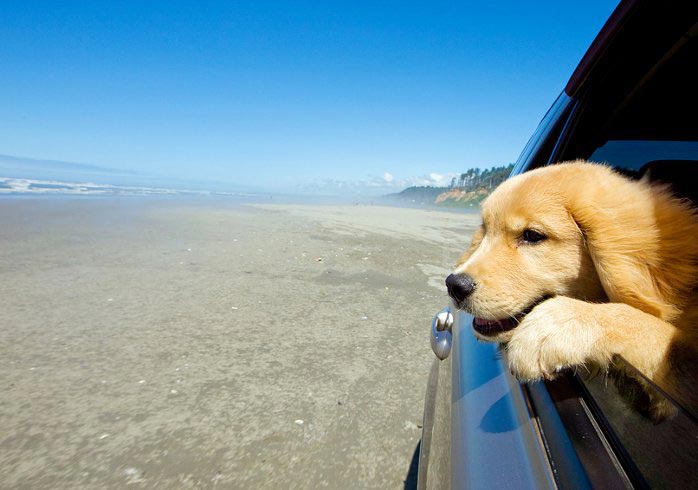
Taking your dog to Denmark
Due to numerous enquiries, we know that there is great uncertainty among dog owners when it comes to planning a holiday in Denmark with their loyal four-footed friends. This is because there has been a new animal protection law in Denmark for some time, which is a matter of concern for many dog owners.
If you want to search the Internet for information on the current situation regarding dog ownership in Denmark, it usually doesn’t make the whole thing easier. You’ll find many conflicting statements and occasionally you’ll even hear supposed horror stories about German tourists whose dogs were simply taken away by the police.
"Can my dog actually be put to sleep just like that?" wonder many uncertain dog owners, and they forego a holiday in Denmark to be on the safe side. Since we know that many holiday home vacationers are also dog owners who would never go on holiday without their beloved pets, we want to try to create some clarity and have familiarised ourselves with the topic for you. We will explain the facts that we have received from Visit Denmark – the Danish tourism centre, the Danish Embassy, and the German Animal Welfare Association as follows.
It should be said in advance that: Dogs are basically welcome in Denmark!
The facts about dog ownership in Denmark
A new dog law has been in place in Denmark since 2010. All rules therein apply both to the locals and to tourists who take their dogs along on holiday.
Which breeds have been banned?
The law basically prohibits 13 breeds and derived crossbreeds for stays in Denmark. These dog breeds are the Pit Bull terrier, Tosa Inu, American Staffordshire Terrier, Fila Brasileiro, Dogo Argentino (Argentinian Mastiff), American Bulldog, Boerboel, Kangal, Central Asian Ovcharka, Caucasian Ovcharka, South Russian Ovcharka, Tornjak, and the Šarplaninac.
The only exception: dogs which belong to these breeds or are descended from them, but were purchased before 17 March 2010 are excluded from the ban. Nevertheless, strict rules also apply here:
- The date of purchase must be verified by a written document.
- The dog must be kept on a leash, which is a maximum of two metres in length. In addition, it has to wear a muzzle.
These rules apply to all public places such as cities, forests, beaches or unfenced properties.
Important to note: Pit Bull Terrier and Tosa Inu breeds are also excluded from these exceptions and are strictly prohibited! No problems are expected if you adhere to the applicable rules with dogs of other breeds.
Which rules should I keep in mind?
Leash obligation: In Denmark, the leash obligation applies to all dogs - no matter how big or small they are or what breed they belong to. A special regulation exists for beaches - the leash obligation is also always enforced here between 1 April and 30 September of each year. During the rest of the year, you may gambol about with your four-legged friends on beaches without a leash. In contrast, the leash obligation applies to forests and other public places all year round.
Dogs in restaurants: Due to concerns about food hygiene, no pets of any kind may be brought into restaurants. Only designated guide dogs are excluded from this regulation.
Injuries caused by my dog: Danish law states that dogs that inflict injuries on other dogs or humans through bites must be put down. According to the Danish Foreign Ministry, "bite injuries" should be understood to mean "great damage caused by a bite". In a narrower sense, this means wounds that require stitches. However, differences must be distinguished in principle:
- Injuries to other dogs: If the attacked dog has to be taken to the vet because of the injury or if it dies or has to be put down, this will be classified as a bite injury.
- Injuries to people : Here, a bite injury is considered as such when the help of a doctor or a hospital stay is necessary.
If a bite injury has been determined, a specific assessment and a decision by the Danish police will be necessary.
The Danish police’s room for manouvre: The police must put forward reasonable grounds to be allowed to request documents about a dog’s origins. They cannot act solely on the basis of the dog’s appearance. However, the law does not specify exactly which documents must be presented. Nevertheless, for example, the breed registry, a genealogical table, or even proof from people who can verify the dog’s heritage will be valid as evidence. The police are entitled to fix a time limit, within which the documents must be submitted.
The important thing to remember is that no dog, even if it belongs to one of the breeds that is considered as dangerous or has caused a bite injury, will be put to sleep immediately. The owner must be given the possibility in each case to comment on the situation and may appeal against the police’s decision.
Which specific travel regulations are there for my four-legged friend?
Entry into the country (important for all holidaymakers in Denmark): It is important that the animal can be identified at any time. For this purpose, the following things should be brought along:
- Chip or tattoo: This is mandatory. It is acceptable for animals to only be identifiable by a chip if they are under three years old.
- Rabies vaccination: The vaccination must not be older than the chip or tattoo. Should a re-vaccination be required, it must be done at least three weeks prior to arrival.
- Pet passport: This must be approved by a vet and provide evidence of a rabies vaccination or revaccination.
Passing through Denmark (important for all travellers who are, for example, on their way to Sweden): All dogs may travel through Denmark. However, this journey should not constitute a longer stay in Denmark. Short breaks, e.g. to take your dog for a walk and get some fresh air, are allowed. However, we advise that you always in principle abide by the above rules.
The good news!
The law is currently being revised. Among other things, the regulations regarding bite injuries to other dogs shall be clarified. Thus, for example, the complicated situation that arises when dogs injure other dogs through playing around with them will be simplified. The Danish Parliament shall focus on revising the law in the coming months.
Further detailed information can be found at the Danish embassy or the German Animal Welfare Association. You can also contact them with specific questions. For example, if you are uncertain about entering the country with a crossbreed.
In our opinion, there is no danger in travelling to Denmark with your dog as long as you adhere to the rules that are in force. Thousands of our customers have travelled to Denmark in the previous year with their faithful companions, and we have not heard of anyone having problems of any kind with their dogs. The Danish Tourist Office and the German Animal Welfare Association have also confirmed that there are no known cases of a tourist’s dog being put down in Denmark.
We hope we have been able give you some useful information on this important topic at hand.
Still looking for a holiday home?
Finally, we would like to show you some holiday homes in Denmark, where it is possible to bring pets along and where many free travel dates for the coming months can still be found:



















